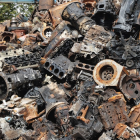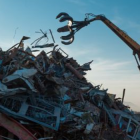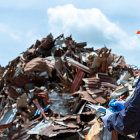Art has always been about creativity, and in recent years, scrap materials have found their way into the hands of innovative artists. From sculptures made from discarded metal to paintings using scrap wood, artists around the world are embracing sustainability by transforming waste into masterpieces. In this blog, we will explore how scrap materials are revolutionizing the art world and why this trend is gaining momentum.
Why Artists are Turning to Scrap Materials
Artists are increasingly aware of environmental issues, and many are looking for ways to incorporate sustainable practices into their work. Scrap materials offer unique textures, shapes, and stories that can’t be found in traditional art supplies. Key reasons for this shift include:
- Sustainability: Using scrap materials helps reduce waste and promotes recycling. It also aligns with the growing eco-conscious mindset of many artists who want to create art that leaves a positive environmental impact.
- Affordability: Scrap materials are often inexpensive or free, making them an attractive option for artists on a budget. From old metal parts to discarded wood, these materials offer endless creative possibilities at little to no cost.
- Creativity and Uniqueness: Scrap materials add character to art. Each piece of scrap has a history and texture that can’t be replicated, allowing artists to create one-of-a-kind works that stand out.
Types of Scrap Materials Used in Art
- Metal Scrap: Artists use old car parts, tools, and machinery to create stunning sculptures and installations. The durability and industrial aesthetic of metal give artworks a modern, edgy feel.
- Wood Scrap: Discarded pallets, beams, and offcuts are transformed into wall art, furniture, and installations, often embracing a rustic or minimalist style.
- Plastic Scrap: Artists are turning old plastic bottles, packaging, and other waste into eye-catching murals, sculptures, and recycled art pieces that draw attention to the global plastic waste crisis.
- Electronic Scrap: Old circuit boards, wires, and broken gadgets are being repurposed into abstract artworks, illustrating the intersection of technology and creativity.
Famous Artists Embracing Scrap Materials
Several renowned artists have gained attention for their work with scrap materials:
- El Anatsui: This Ghanaian artist uses discarded bottle caps, aluminum, and copper wire to create large-scale, intricate sculptures that reflect African traditions and global waste issues.
- Vik Muniz: Brazilian artist Vik Muniz creates stunning portraits and landscapes using garbage and scrap materials, often depicting individuals who work in recycling centers.
- Jane Perkins: This UK-based artist repurposes old buttons, beads, and plastic toys to recreate famous paintings and portraits, adding texture and vibrancy to her works.
The Role of Scrap Art in Promoting Environmental Awareness
Art made from scrap materials often carries a powerful environmental message. By using waste as their medium, artists draw attention to issues like overconsumption, pollution, and the importance of recycling. Many scrap art exhibitions focus on sustainability, encouraging viewers to reflect on the impact of waste and consider their role in preserving the planet.
Conclusion
The use of scrap materials in the art world is a growing trend that promotes both sustainability and creativity. Artists are proving that beauty can be found in waste and that discarded materials can be transformed into meaningful, thought-provoking works of art. As more artists embrace this eco-friendly approach, scrap art will continue to inspire new conversations about the intersection of creativity, waste, and the environment.






